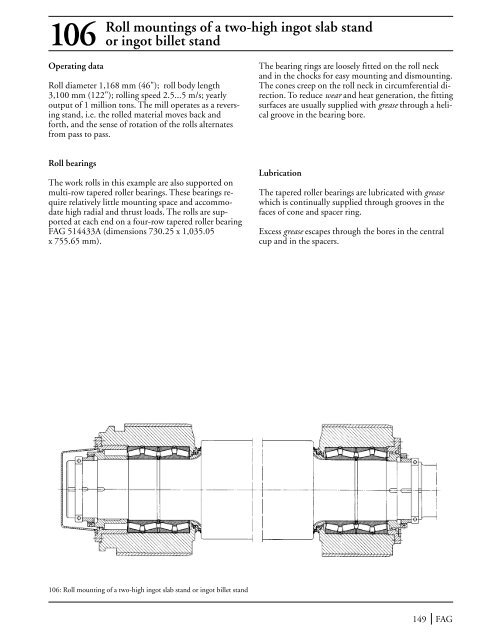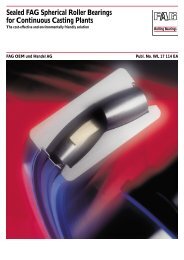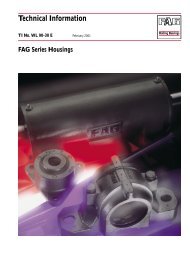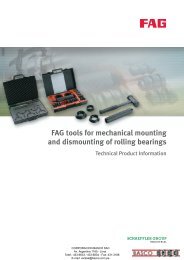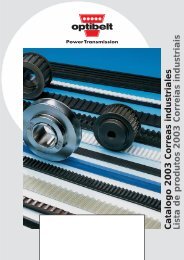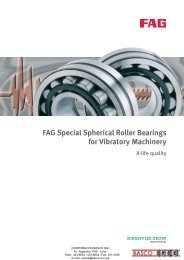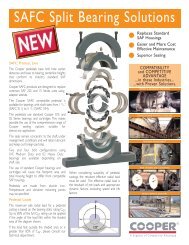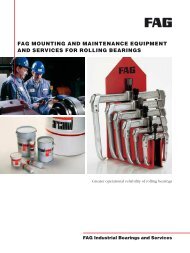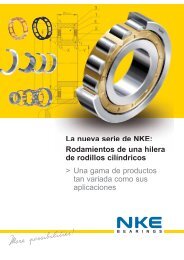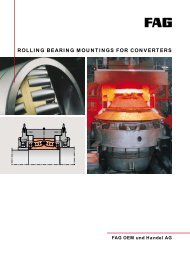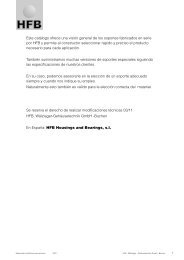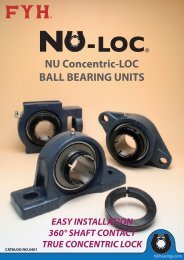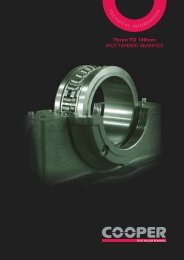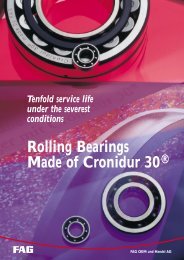- Page 3:
PrefaceThis publication presents de
- Page 6 and 7:
ContentsExample Title . . . . . . .
- Page 8 and 9:
assembly is contracted. Thus the ra
- Page 10 and 11:
Current insulationWhere converter c
- Page 12 and 13:
4 Electric motor for domestic appli
- Page 14 and 15:
PulleyDrum5: Drum mounting of a dom
- Page 16 and 17:
6: Rotor bearing arrangement of a v
- Page 18:
7: Rotor bearing arrangement of a m
- Page 21 and 22:
9-18 Work spindles of machine tools
- Page 23 and 24:
10 NC-lathe main spindleOperating d
- Page 26 and 27:
13 High-speed motor milling spindle
- Page 28 and 29:
15 Vertical high-speed milling spin
- Page 30 and 31:
17 External cylindrical grinding sp
- Page 32 and 33:
19 Rotary table of a vertical lathe
- Page 34 and 35:
21 Rough-turning lathe for round ba
- Page 36 and 37:
22: Flywheel bearing arrangement of
- Page 38 and 39:
24 Double-shaft circular sawOperati
- Page 40 and 41:
Rollbending bearingsA counterbendin
- Page 42 and 43:
27 Spur gear transmission for a rev
- Page 44 and 45:
The effects of basing the bearing d
- Page 46 and 47:
29 Bevel gear - spur gear transmiss
- Page 48 and 49:
31 Worm gear pairOperating dataInpu
- Page 50 and 51:
at least normal cleanliness (contam
- Page 52 and 53:
33 Manual gearbox for trucksOperati
- Page 54:
34 Final drive of a passenger carOp
- Page 57 and 58:
Driven and non-steered rear wheel36
- Page 59 and 60:
38 Steering king pin of a truckA va
- Page 61 and 62:
40 Water pump for passenger car and
- Page 63 and 64:
42 Axle box roller bearings of an I
- Page 65 and 66:
43-44 UIC axle box roller bearings
- Page 67 and 68:
45Axle box roller bearingsof series
- Page 69 and 70:
47Axle box roller bearingsof the Ch
- Page 71 and 72:
48 Axle box roller bearings for an
- Page 73 and 74:
50Axle box roller bearingsaccording
- Page 75 and 76:
52Universal quill drivefor threepha
- Page 77 and 78:
54 Spur gear transmission for the u
- Page 79 and 80:
55 Bevel gear transmission for city
- Page 81 and 82:
56- 57 Spherical roller bearings as
- Page 83 and 84:
60 Spade-type rudderDesignThe slewi
- Page 85 and 86:
61-62 Ship shaft bearings and stern
- Page 87 and 88:
63-64 Ship shaft thrust blocksThe t
- Page 89 and 90:
64a: Complete ship shaft thrust blo
- Page 91 and 92:
65 RefinersWood chips from the wood
- Page 93 and 94:
66 Suction rollsSuction rolls are f
- Page 95 and 96:
68 Dryer rollsThe remaining water i
- Page 97 and 98:
69 Guide rollsGuide rolls guide, as
- Page 99 and 100: 70 Calender thermo rollsThe paper p
- Page 101 and 102: 71 Anti-deflection rollsAnti-deflec
- Page 103 and 104: 73 Run wheel of a material ropewayO
- Page 105 and 106: 74 Rope return sheaves of a passeng
- Page 107 and 108: 75 Rope sheave (underground mining)
- Page 109 and 110: 76 Rope sheave of a pulley blockIn
- Page 111 and 112: 77 Crane pillar mounting with a sph
- Page 113 and 114: 79 Roller track assemblyThe radial
- Page 115 and 116: 80 Crane run wheelOperating dataWhe
- Page 117 and 118: 81 Crane hookThe load suspended fro
- Page 119 and 120: 83 Head pulley of a belt conveyorOn
- Page 121 and 122: Internal bearings for the tension/8
- Page 123 and 124: Belt conveyor idlersMany industries
- Page 125 and 126: 87 Bucket wheel shaft of a bucket w
- Page 127 and 128: 89 Drive unit of a finished goods e
- Page 129 and 130: 91 Vibrating road rollerThe vibrati
- Page 131 and 132: 92 Double toggle jaw crusherDouble
- Page 133 and 134: 94 Double-shaft hammer crusherDoubl
- Page 135 and 136: 95 Ball tube millTube mills are mos
- Page 137 and 138: 96 Support roller of a rotary kilnR
- Page 139 and 140: Vibrating machinesVibrating screens
- Page 141 and 142: 98 Two-bearing screen with straight
- Page 143 and 144: 99 Four-bearing screenThe vibration
- Page 145 and 146: 101-103 Large capacity convertersCo
- Page 147 and 148: 104Roll bearings of afour-high cold
- Page 149: Work rolls for the finishing sectio
- Page 153 and 154: 108 Work rolls of a section millThe
- Page 155 and 156: Two-high rolls of a dressing stand1
- Page 157 and 158: 110 Straightening rolls of a rail s
- Page 159 and 160: 111 Disk ploughIn a disk plough the
- Page 161 and 162: 112 Plane sifterSifters are used in
- Page 163 and 164: Printing pressesPrinting quality is
- Page 165 and 166: 114 Blanket cylinder of a sheet-fed
- Page 167 and 168: 116 Axial piston machineCylinder bl
- Page 169 and 170: 117 Axial piston machineOperating d
- Page 171 and 172: 119 Hot gas fanGas temperature 150
- Page 173 and 174: 121 Optical telescopeOperating data
- Page 175 and 176: 122-124 RadiotelescopeFor radioastr
- Page 177 and 178: 123 Azimuth axis (track roller and
- Page 179 and 180: GlossaryAdditivesAdditives are oil-
- Page 181 and 182: GlossaryAxial clearanceThe axial cl
- Page 183 and 184: GlossaryContamination factor VThe c
- Page 185 and 186: GlossaryEP additivesWear-reducing a
- Page 187 and 188: Glossary1. Safe retention and unifo
- Page 189 and 190: GlossaryLoad angleThe load angle i
- Page 191 and 192: Glossaryload and the ring to be fit
- Page 193 and 194: Glossaryaligning ball bearings, bar
- Page 195 and 196: GlossaryViscosityViscosity is the m
- Page 197 and 198: NotesFAG 196


